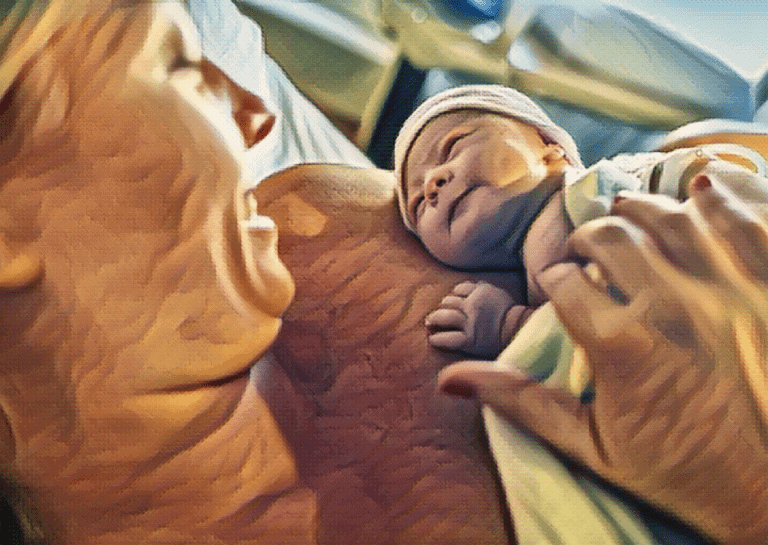Newborns nap a lot. You may not believe me if you’re not getting much sleep right now, but on average, newborns sleep somewhere around 16 hours a day during their first month of life. While they may do a lot of sleeping, it’s not typically in long increments. Most newborns sleep around one to two hours at a time. Longer stretches of sleep, or sleeping through the night, usually don’t happen until three months of age.
Even though sleep may not be a big part of your experience with a newborn (sorry sleep-deprived parents!), it is a big part of your newborn’s earliest days. That’s why it’s crucial to create a safe and comfortable environment so your newborn can enjoy those sixteen hours of beauty sleep.
Risks of an unsafe sleeping environment
Beyond not getting the sleep they need, there are some pretty serious risks to not following the American Academy of Pediatric’s recommendations about creating a safe sleeping environment for your newborn. When bedding accessories like loose sheets or blankets are left in a crib with your baby, there’s a risk for suffocation or strangulation.
SIDS, or sudden infant death syndrome, is another risk of unsafe sleeping environments and is defined as the sudden passing of an infant under one year of age that can’t be explained after a thorough investigation. While other underlying factors contribute to the risk of SIDS in your baby, like prematurity or low birth weight, one of the most controllable factors is sleep position and environment.
Newborns who sleep on their stomachs or side are more at risk for SIDS than infants that sleep on their backs. A soft sleeping surface has also consistently proven to be a risk factor in case-controlled studies. In one study, a soft sleep surface increased the risk of SIDS fivefold. Loose bedding items like blankets, pillows and stuffed animals also increase the risk of SIDS by five times. Things like bed-sharing, swaddling and overheating also increase the risk for the occurrence of SIDS.
That’s why it’s important to know what increases the risk of SIDS and other dangers to your newborn within their sleep environment. By staying vigilant, you can ensure they’re getting the safest possible rest while you at least get peace of mind, if not sleep.
What to avoid
While napping during short drives is fine, your baby shouldn’t regularly sleep in a car seat. Swings shouldn’t be a routine napping spot, either. The inclined position doesn’t provide the support and optimal sleeping position for your baby, creating a risk for them to experience difficulty breathing, potentially even suffocation.
For those who use slings to carry their infant, it’s important to remember that your baby’s head should always be above the fabric, you can see your baby’s face, and their nose and mouth are clear of obstructions. While they’re handy, if you notice your baby falling asleep, you should move them to a crib or firm and flat sleeping surface as soon as you can. Soft surfaces like beds or couches aren’t recommended for newborns, either. According to the AAP, they’ve been proven to increase the risk of SIDS and could pose a risk for entrapment or suffocation.
Where your newborn should nap
The safest place for your infant to nap is in a crib or bassinet with a firm sleeping surface. When you’re picking a crib, you should always be sure it meets the current safety standards of the Consumer Product Safety Commission. The CPSC recommends a crib with no dropside rail, slats that are no further apart than 2 and ⅜ inches apart, and has a firm sleeping surface, which you can test by pressing down on the mattress on all sides and ensuring it springs back in place quickly.
It’s also important to check that all the hardware fits correctly and isn’t loose and that no paint is chipping off the crib. The same safety requirements apply when using a bassinet or play yard.
The safest sleeping environment offers a firm sleep surface and is free of any loose bedding accessories like blankets, pillows, or other objects like toys. Something like the Snoo makes it easy to know your newborn has a safe sleeping setup.
Your baby should always sleep on their backs, otherwise known as the supine position. The American Academy of Pediatrics recommends the supine position through at least the first year of life for naps and nighttime sleep.
As you can see, sleep and where your newborn does it is a pretty big deal. You want to be sure that something they’re doing a lot of, is being done safely. By following the recommendations of the AAP and addressing any questions with your pediatrician, you can have a mind that’s at rest while your baby rests.
